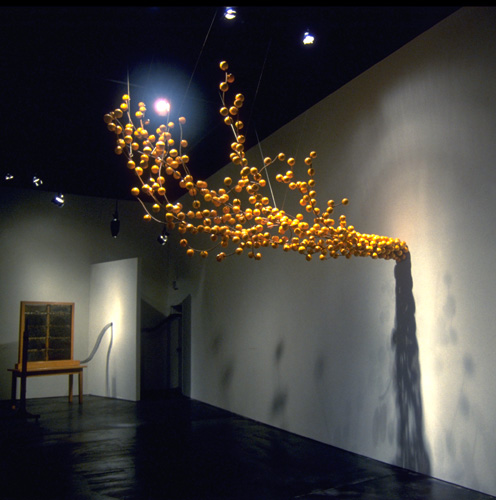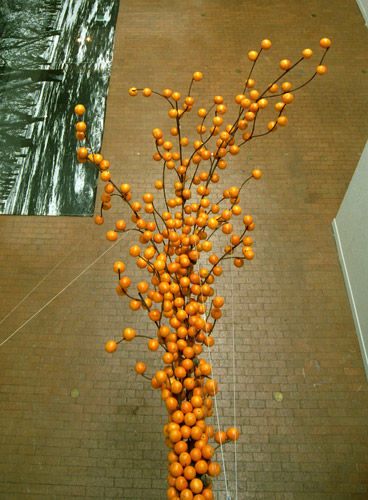Rotting
Flame I, first shown in, Color in the Shadows, Bay
Area Cyber Art, along with the video, Deluge
(Radiant Sleep/Helium
Ash), 1994, is
comprised of a branching steel armature in the shape
of a large
flame
with over
400
ripe oranges
impaled
on spikes projecting from the structure. The structure
is suspended out from a wall held in space by fine metal
cables, the oranges are allowed to decay naturally given
the conditions of the surrounding atmosphere. Rotting Flame II was constructed in Korea from images of Rotting Flame I, for the exhibition: Adventures of the Fire, as part of The 5th World Ceramic Biennale Korea, Icheon World Ceramic Center, Icheon, Korea – April 25-June 24, 2009.
Rotting
Flame I & II are instruments of chemical transformation and
time. The processes of fire and decay are essentially two
forms of oxidation/reduction, fire is relatively fast and decay is
much slower. In this sense Rotting Flame I & II are the
image of fire animated within the time frame of the decay
of oranges. The orange color of the citrus also parallels
the orange incandescence of unburnt carbon particles
of a reducing flame.
|
Important
antecedents to Rotting Flame I & II were a series of site-process,
kiln works from the late 1970’s into the early 1990’s
in which fire was the essential agent of physical and durational
change. Land
Monitor/Fired Volcanic Boulder, 1980, Wave
Ship (of Fire), 1984, Untitled
(Earth Orchid), 1988 and Metabolism and Mortality/O2,
1992 are exemplary of this series. In
these environmental projects the fire was an agent of change
in the geologic sense, used
to alter earth materials within a site-developed furnace
structure; here geologic time was compressed into human time
by speeding up the normally glacial rate of geologic transformations.
Rotting
Flame I & II also engage metaphorically with metabolic
and entropic change associated with landscape, photosynthesis
and other bio/geochemical cycles as well as human metabolism,
agriculture and energy systems. Many of these concepts
were further explored in a subsequent body of process/photo
works such as Robes I &
II, 1995, Séance
(Entropic) I & II,
1995 and Thyroid
Portraits/Knights (1-6), as well as in the sculptures,
Surrogate System, 1995 and Novum
Organum II (Two Suns), 1998.
John
Roloff, 1994/1999/2009
|


